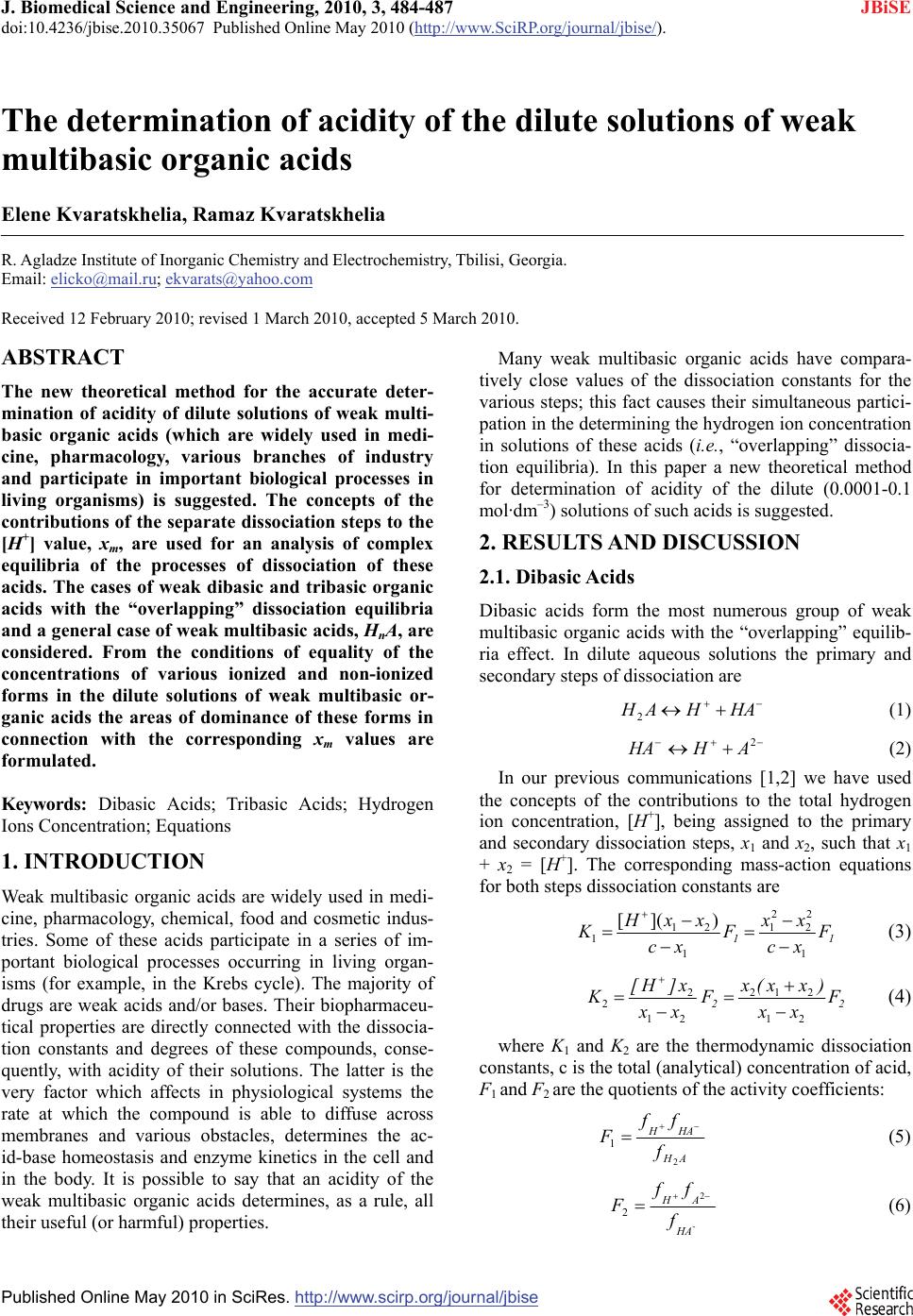
J. Biomedical Science and Engineering, 2010, 3, 484-487
doi:10.4236/jbise.2010.35067 Published Online May 2010 (http://www.SciRP.org/journal/jbise/
JBiSE
).
Published Online May 2010 in SciRes. http://www.scirp.org/journal/jbise
The determination of acidity of the dilute solutions of weak
multibasic organic acids
Elene Kvaratskhelia, Ramaz Kvaratskhelia
R. Agladze Institute of Inorganic Chemistry and Electrochemistry, Tbilisi, Georgia.
Email: elicko@mail.ru; ekvarats@yahoo.com
Received 12 February 2010; revised 1 March 2010, accepted 5 March 2010.
ABSTRACT
The new theoretical method for the accurate deter-
mination of acidity of dilute solutions of weak multi-
basic organic acids (which are widely used in medi-
cine, pharmacology, various branches of industry
and participate in important biological processes in
living organisms) is suggested. The concepts of the
contributions of the separate dissociation steps to the
[H+] value, xm, are used for an analysis of complex
equilibria of the processes of dissociation of these
acids. The cases of weak dibasic and tribasic organic
acids with the “overlapping” dissociation equilibria
and a general case of weak multibasic acids, HnA, are
considered. From the conditions of equality of the
concentrations of various ionized and non-ionized
forms in the dilute solutions of weak multibasic or-
ganic acids the areas of dominance of these forms in
connection with the corresponding xm values are
formulated.
Keywords: Dibasic Acids; Tribasic Acids; Hydrogen
Ions Concentration; Equations
1. INTRODUCTION
Weak multibasic organic acids are widely used in medi-
cine, pharmacology, chemical, food and cosmetic indus-
tries. Some of these acids participate in a series of im-
portant biological processes occurring in living organ-
isms (for example, in the Krebs cycle). The majority of
drugs are weak acids and/or bases. Their biopharmaceu-
tical properties are directly connected with the dissocia-
tion constants and degrees of these compounds, conse-
quently, with acidity of their solutions. The latter is the
very factor which affects in physiological systems the
rate at which the compound is able to diffuse across
membranes and various obstacles, determines the ac-
id-base homeostasis and enzyme kinetics in the cell and
in the body. It is possible to say that an acidity of the
weak multibasic organic acids determines, as a rule, all
their useful (or harmful) properties.
Many weak multibasic organic acids have compara-
tively close values of the dissociation constants for the
various steps; this fact causes their simultaneous partici-
pation in the determining the hydrogen ion concentration
in solutions of these acids (i.e., “overlapping” dissocia-
tion equilibria). In this paper a new theoretical method
for determination of acidity of the dilute (0.0001-0.1
mol·d m–3) solutions of such acids is suggested.
2. RESULTS AND DISCUSSION
2.1. Dibasic Acids
Dibasic acids form the most numerous group of weak
multibasic organic acids with the “overlapping” equilib-
ria effect. In dilute aqueous solutions the primary and
secondary steps of dissociation are
HAHAH2 (1)
2
AHHA (2)
In our previous communications [1,2] we have used
the concepts of the contributions to the total hydrogen
ion concentration, [H+], being assigned to the primary
and secondary dissociation steps, x1 and x2, such that x1
+ x2 = [H+]. The corresponding mass-action equations
for both steps dissociation constants are
11 F
xc
xx
F
xc
xxH
K
1
2
2
2
1
1
21
1
)]([
(3)
22 F
xx
)xx(x
F
xx
x]H[
K
21
212
21
2
2
(4)
where K1 and K2 are the thermodynamic dissociation
constants, c is the total (analytical) concentration of acid,
F1 and F2 are the quotients of the activity coefficients:
AH
HAH
f
ff
F
2
1
(5)
-
HA
AH
f
ff
F
2
2 (6)